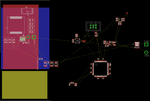David_
Advanced Member level 2

Hmm, I have to read about DrMOS because I have never even heard of it.
Some things seems to be assumed that the user would know or understand(which probably is reasonable since I don't think that people like me is the usual user nor the intended target consumer) but an example would be the REFIN pins function.
All I can find out is that REFIN's function is "External reference voltage input for current sensing amplifier", and that it's absolute maximum rating is -0,3V up to VDD + 0,3V.
But what does that actually mean? Is it the voltage that supplies the opamp that is used to sense the current by some means, or is it a voltage that the output of the current sense opamp is scaled to, or is it something that simply limits how high the output voltage of the current sense amplifiers(whatever that is made out of) can get... I really don't understand the meaning of this pin and relevant to that is also that I don't know anything about the current sense output's range or meaning.
All that I can find out about the IOUT pin is that it's function is "Output of current sensing amplifier. V(IOUT) – V(REFIN) is proportional to the phase current.", but that doesn't tell me anything about how to interpret that voltage does it?
(VSW pin = Phase node connecting the HS MOSFET source and LS MOSFET drain – pin connection to the output inductor.)
"proportional" isn't worth anything if I don't know anything about at what ratio it is proportional, lets say that I am feeding 3V to REFIN, and the output during steady state operation of the converter is let's say 1V. What does that mean?
I looked up DrMOS quickly and I see that it establishes some sort of standard that any such device should adhere to in some aspects, I read this document which paints that picture at least.
When you say alternative to DrMOS, do you mean something that could replace DrMOS(while establishing it's own "rules" without regard for DrMOS) or do you mean something that is compatible with DrMOS?
- - - Updated - - -
Then I also wonder about the bandwidth of the current sense amplifier, how can I hope to utilize it... Can I count on it being able to supply pulse-pulse current information or is it more of an general output current figure...
Unless I find any more specific information about it I have to implement a separate current sensing circuit(which I might be forced to do even with that information depending on what that information says).
Some things seems to be assumed that the user would know or understand(which probably is reasonable since I don't think that people like me is the usual user nor the intended target consumer) but an example would be the REFIN pins function.
All I can find out is that REFIN's function is "External reference voltage input for current sensing amplifier", and that it's absolute maximum rating is -0,3V up to VDD + 0,3V.
But what does that actually mean? Is it the voltage that supplies the opamp that is used to sense the current by some means, or is it a voltage that the output of the current sense opamp is scaled to, or is it something that simply limits how high the output voltage of the current sense amplifiers(whatever that is made out of) can get... I really don't understand the meaning of this pin and relevant to that is also that I don't know anything about the current sense output's range or meaning.
All that I can find out about the IOUT pin is that it's function is "Output of current sensing amplifier. V(IOUT) – V(REFIN) is proportional to the phase current.", but that doesn't tell me anything about how to interpret that voltage does it?
(VSW pin = Phase node connecting the HS MOSFET source and LS MOSFET drain – pin connection to the output inductor.)
"proportional" isn't worth anything if I don't know anything about at what ratio it is proportional, lets say that I am feeding 3V to REFIN, and the output during steady state operation of the converter is let's say 1V. What does that mean?
I looked up DrMOS quickly and I see that it establishes some sort of standard that any such device should adhere to in some aspects, I read this document which paints that picture at least.
When you say alternative to DrMOS, do you mean something that could replace DrMOS(while establishing it's own "rules" without regard for DrMOS) or do you mean something that is compatible with DrMOS?
- - - Updated - - -
Then I also wonder about the bandwidth of the current sense amplifier, how can I hope to utilize it... Can I count on it being able to supply pulse-pulse current information or is it more of an general output current figure...
Unless I find any more specific information about it I have to implement a separate current sensing circuit(which I might be forced to do even with that information depending on what that information says).









